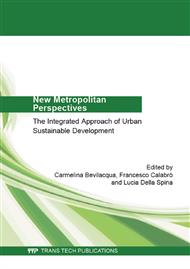[1]
D. E. MASSIMO set up the research and authored paragraphs 2, 5, 6. M. MUSOLINO authored paragraphs 4 and 9. A. BARBALACE set up the General Information System for Valuation and appraisal (SGV), coordinated the operational research, authored paragraph 1 and 7. C. FRAGOMENI set up the link between SGV and the Case Study and authored paragraphs 3 and 8.
Google Scholar
[1]
D. E. Massimo: Valuation of Urban Sustainability and Building Energy Efficiency. A Case Study. In: International Journal of Sustainable Development, Vol. 12, (2009).
Google Scholar
[2]
P. Nijkamp, F. Bal, F. Medda: A survey of methods for sustainable city planning and cultural heritage management. In: European Union Commission, Raphael Programme, Rome. Mimeo (1999).
Google Scholar
[3]
P. Nijkamp, R. Vreeker: Sustainability Assessment of Development Scenarios: Methodology and Application to Thailand. In: Ecological Economics, n. 33, (2000), pp.7-27.
DOI: 10.1016/s0921-8009(99)00135-4
Google Scholar
[4]
D. E. Massimo, A. Barbalace: Urban sprawl e crescita economica territoriale. La sfida della scala in una stima a livello sub-regionale. In: Atti della XXX Conferenza Italiana di Scienze Regionali, AISRe. Federalismo, integrazione europea e crescita regionale. Firenze, 09-11. 09. 2009. AISRe, Milano. CD-Rom. (2009a).
DOI: 10.3280/scre2012-001003
Google Scholar
[5]
D. E. Massimo, A. Barbalace: Valutazione dell' urban sprawl e strumenti GIS. In: Asita (ed): Federazione delle Associazioni Scientifiche per le Informazioni Territoriali ed Ambientali. Asita, Milano, Vol. II: pp.1399-1404.
Google Scholar
[6]
D. E. Massimo et alii.: GIS dello sprawl urbanistico. Recenti innovazioni nelle stime quantitative. In: Atti della Dodicesima Conferenza Nazionale Utenti ESRI. GIS in action. Roma, 27-28. 05. 2009. ESRI Italia, Roma. CD-Rom. (2009).
Google Scholar
[7]
D. E. Massimo, M. Musolino, A. Barbalace: Urban sprawl e valutazione di infrastrutture di trasporto. Un Caso di Studio nell'area centrale della Calabria. In: Marone E. (ed): La Valutazione degli Investimenti Infrastrutturali Urbani ed Extraurbani. Aspetti Giuridici, Estimativi ed Ambientali. Firenze University Press, Firenze. ISSN: 1826-249X. (2010).
DOI: 10.36253/8884533066
Google Scholar
[8]
D. E. Massimo, A. Barbalace, A. P. P. Massimo, R. M. Cefalà: Valutazione a criteri multipli di alternative di trasporto per fronteggiare lo sprawl. In: Marone E. (ed): La valutazione degli investimenti pubblici per le politiche strutturali. Firenze University Press, Firenze (2011).
DOI: 10.3280/riv2008-040004
Google Scholar
[9]
S. Stanghellini (ed): La selezione dei progetti e il controllo dei costi nella riqualificazione urbana territoriale. Alinea Editrice, Firenze (2004), pp.217-242.
DOI: 10.3280/ei2017-002002
Google Scholar
[10]
D. E. Massimo, M. Musolino, A. Barbalace: Uno strumento integrato economico-urbanistico per il governo territoriale di area vasta. Il Sistema Generale di informazione per la Valutazione, SGV. Un caso applicativo. In: Marone E. (ed): Area vasta e governo del territorio. Nuovi strumenti giuridici, economici ed urbanistici. Firenze University Press, Firenze (2006).
DOI: 10.3280/scre2013-002004
Google Scholar
[11]
P. Nijkamp: Culture and Region: a multidimensional evaluation of monuments. In: Environment and Planning B, n. 15, (1988), pp.5-15.
Google Scholar
[12]
J. Rothenberg: Lectures of the Course 1. 1485-14. 111J: Economics of Project Evaluation. Dep. of Civ. Eng. and Dep. of Econ., Massachusetts Institute of Technology, Cambridge, MA (on magnetic tapes) (1990).
Google Scholar
[13]
T. L. Saaty: The Analytic Hierarchy Process: Planning, Priority Setting, Resource Allocation. McGraw-Hill International Book Company. New York. ISBN 0-07-054371-2 (1980).
Google Scholar
[14]
E. Hinloopen: De Regime Methode. Doctoraalscriptie Interfaculteit Actuariaat en Economie. Vrije Universiteit, Amsterdam. 25 April 1985. Mimeo (1985).
Google Scholar
[15]
E. Hinloopen, P. Nijkamp: Regime-methode voor ordinale multicriteria-analyses; Een beschouwing en een commentaar. [Regime-method for ordinal multicriteria analysis; an evaluation and a critique] Rev. Kwantitatieve Methoden, 22, (1986), pp.61-78.
Google Scholar
[16]
E. Hinloopen, P. Nijkamp: Qualitative multiple criteria choice analysis. The Dominant Regime Method. In: Quality and Quantity, 24, (1990), pp.37-56.
DOI: 10.1007/bf00221383
Google Scholar


